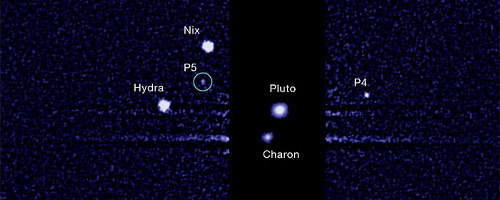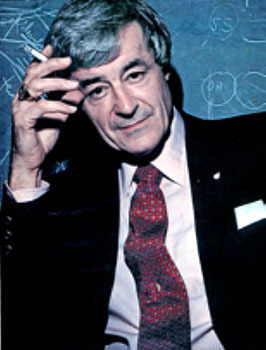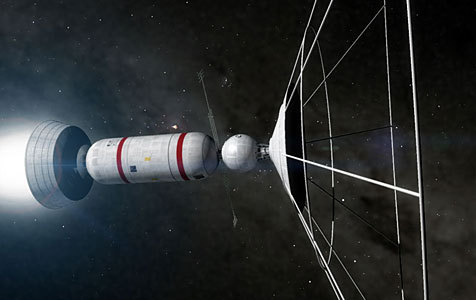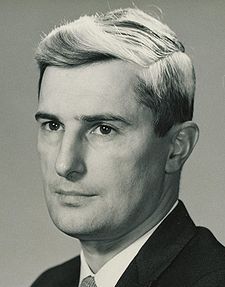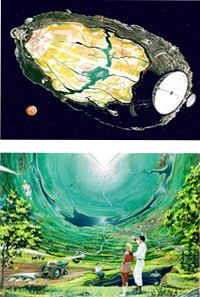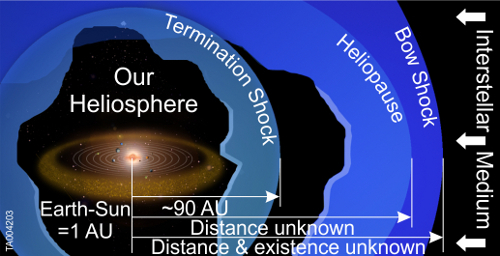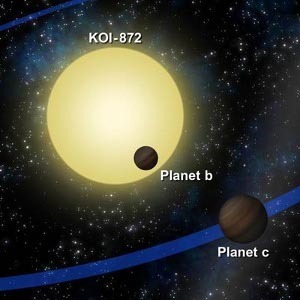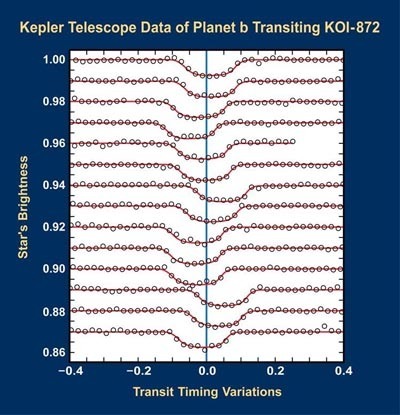Paul Gilster's Blog, page 245
July 20, 2012
Medusa: Nuclear Pulse Propulsion and the Sail
Hybrid propulsion technologies have emerged naturally as we look at ways to reach the stars. They’re the result of trying to extract maximum performance from each option, and it sometimes turns out that putting two ideas together works better than either by itself. Next week we’ll be looking at one such concept, A. A. Jackson’s idea of combining the Bussard ramjet with laser beaming in ways that turn out to be surprisingly effective. Today I want to start the hybrid discussion – already about a week late because of competing news — by talking about Johndale Solem’s ‘Medusa,’ a combination of sail technologies with nuclear pulse propulsion.
Solem’s work evidently draws on the ideas of Ted Cotter at Los Alamos in the 1970s, which evolved into what George Dyson has described as a ‘rotating-cable pusher.’ Think back to the Orion concept, with its immense pusher-plate and shock absorbers that would withstand the explosion of nuclear devices behind the plate, propelling the vehicle forward while protecting the crew. What Cotter had in mind was doing away with the pusher-plate and instead having the ship, as it spun slowly around its axis, unreel steel cables that would radiate out from the vehicle, in Dyson’s words, ‘like the arms of a giant squid.’ With flattened plates at the end of each, the cables would absorb momentum from the explosions set off behind the vehicle.
I assume the squid reference came from George Dyson’s father, for Freeman Dyson is credited in his son’s book Project Orion: The True Story of the Atomic Spaceship as being the author of a 1958 memo, still classified, called ‘The Bolo and the Squid.’ That places early thinking on this highly modified concept all the way back in the days of active Orion research, which were complemented by a revival at Los Alamos in the early 1970s that resulted in Cotter’s work. It’s natural enough that Johndale Solem, himself working at Los Alamos, should have been the one to take the concept one step further with a design he called Medusa because it would mimic the motion of a jellyfish moving through the ocean as it moved through space. In a 1991 Los Alamos report, Solem wrote:
One can visualize the motion of this spacecraft by comparing it to a jellyfish. The repeated explosions will cause the canopy to pulsate, ripple, and throb. The tethers will be stretching and relaxing. The concept needed a name: its dynamics suggested Medusa.
Thus the scheme: Solem would likewise do away with the pusher plate of Orion, replacing it with a large sail deployed well ahead of the vehicle, with nuclear explosions to be detonated between the two so as to drive the sail and attached vehicle forward. You can see the basic idea in the illustration below. The Medusa idea evolves naturally from some of the problems inherent in the Orion design. No matter how large the pusher-plate, it could only receive a fraction of the momentum from the bomb blast debris, but even so, it had to be massive, and so did the shock absorbers that protected the crew. Solem realized that his sail could create a canopy that could intercept a much larger angle from the detonation point, and that the tethers could be made long and elastic enough to smooth out the acceleration experienced by the canopy.
Solem also considered a combination of tethers working with a servo winch in the space vehicle itself, a method with several advantages, as suggested in the same Los Alamos report:
When the explosive is detonated, a motorgenerator powered winch will pay out line to the spinnaker at a rate programmed to provide a constant acceleration of the space capsule. The motorgenerator will provide electrical power during this phase of the cycle, which will be conveniently stored. After the space capsule has reached the same speed as the spinnaker, the motorgenerator will draw in the line, again at a rate programmed to provide a constant acceleration of the space capsule. The acceleration during the draw-in phase will be less than during the pay-out phase, which will give a net electrical energy gain. The gain will provide power for ancillary equipment in the space capsule…
Image: Medusa in operation. Here we see the design 1) At the moment of bomb explosion; 2) As the explosion pulse reaches the parachute canopy; 3) Effect on the canopy, accelerating it away from the explosion, with the spacecraft playing out the main tether with its winch, braking as it extends, and accelerating the vehicle; 4) The tether being winched back in. Imagine all this in action and the jellyfish reference becomes clear. Credit: George William Herbert/Wikimedia.
Solem was keenly aware of the radiation problem posed by Orion, noting that Medusa would be assembled in space and probably launched from one of the Lagrange points, well out of the magnetosphere so that no charged particles would be trapped into Earth-bound trajectories. Interestingly, he thought of Medusa in terms of interplanetary rather than interstellar flight, noting that a major benefit of the proposal would be to reduce travel times that would lead to crew exposure to solar flare radiation and galactic cosmic rays. Such exposure led to proposals for massive shielding, whereas the swift Medusa would cut travel times by a factor of 5 to 10, with part of the shield being made up of the nuclear bombs that would be used as fuel. He even envisions astronauts using a crawl space inside the fuel as shelter during a solar storm.
Solem believed the best canopy material would be a high-strength aligned polyethylene of the kind that advances in materials technology should make available in the future. In the Los Alamos report he notes that:
We can reduce the mass of the canopy indefinitely by increasing its radius and the number of tethers. The tethers and the canopy material become progressively thinner. Mylar can be fabricated to a thickness of about ¼ mil, but other practical considerations, such as cost, will come into play long before the fabrication limit is reached. I will be conservative and say that we can spin-deploy a canopy 500 m in radius with 104 tethers.
More about Medusa, its possible interstellar applications, and hybrid mission designs on Monday. The Los Alamos report I refer to above is Solem’s “Some New Ideas for Nuclear Explosive Spacecraft Propulsion,” LA-12189-MS, October 1991 (available online). Solem also wrote up the Medusa concept in “Medusa: Nuclear Explosive Propulsion for Interplanetary Travel,” JBIS Vol. 46, No. 1 (1993), pp. 21-26. Two other JBIS papers also come into play for specific mission applications — I’ll give the citations for those next week.






July 19, 2012
Proximity Hunt: Exoplanets Around Nearby Stars
Finding new worlds with Kepler is an absorbing occupation, but the one thing missing from most exoplanet news is proximity. While we continue to search for planets around the Alpha Centauri stars, the closest candidate I know about is the gas giant thought to orbit Epsilon Eridani, some 10.5 light years out. If you’re looking for potential habitability, you have to extend all the way out to Gliese 581 (almost twice the distance), where planets are plentiful and there is at least the chance (GL 581d) that one skirts the edge of the habitable zone. There are probably many planets closer than 20 light years, but we don’t have the tools in space to find them easily.
Kepler, you’ll recall, studies a field of stars in Cygnus, Lyra and Draco, the goal being to develop a statistical approximation of the prevalence of Earth-sized planets in the galaxy. Looking out along the Orion arm, Kepler is watching stars anywhere from 600 to 3000 light years away. In fact, fewer than 1 percent of the stars Kepler sees are closer than 600 light years. We have missions on the drawing board like TESS — Transiting Exoplanet Survey Satellite — which are designed to study 2.5 million of the brightest stars in the sky, looking for nearby transiting planets, and the European Space Agency’s PLATO — PLAnetary Transits and Oscillations of stars — would likewise go to work on relatively bright stars near our Solar System.
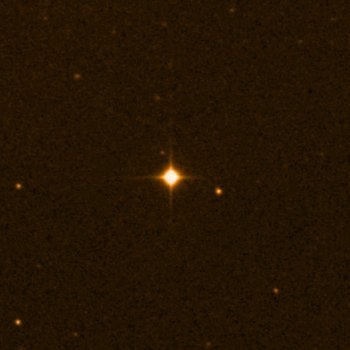
Will these missions ever fly? While we wait for the inexorable review process to grind its way forward, it’s gratifying to see the discovery of another planet that’s not, in astronomical terms, all that far away. The candidate exoplanet, UCF-1.01, is 33 light years from us orbiting the red dwarf GJ 436, already known to be home to a hot Neptune designated GJ 436b. Working at the University of Central Florida, Kevin Stevenson and colleagues went to work on what appeared to be the signature of a small planet, going through observations from Spitzer as well as the Deep Impact spacecraft, the Very Large Telescope and the Canada-France-Hawaii Telescope on Mauna Kea. The find marks the first time Spitzer has been used in a transit discovery.
Image: GJ 436, a red dwarf in the constellation of Leo with a ‘hot Neptune’ and two new exoplanet candidates. Credit: ESO Online Digitized Sky Survey.
It’s an interesting little world, this UCF-1.01, with a diameter estimated at 8400 kilometers, or about two-thirds that of the Earth, quite a catch for Spitzer, which some project scientists believe may be able to discover exoplanets no larger than Mars. UCF-1.01 would orbit its star in a snappy 1.4 days, with surface temperatures reaching close to 600 degrees Celsius. Due to its size and proximity to the host star, the planet is unlikely to have retained its original atmosphere, though the paper does note that impacts or tidal heating could create a transient atmosphere.
Most likely, this is a dead, cratered world, conceivably a place covered in magma, according to Joseph Harrington (UCF), a co-author on the paper. If confirmed, the new world will be called GJ 436c, but the UCF team is not done yet. There is also evidence for a third world in this system, dubbed UCF-1.02. Confirming the new worlds will involve additional work. From the paper:
To definitively establish UCF-1.01 as a planet (to be called GJ 436c), we require only a few hours of additional observations, preferably from another telescope or at least at a different wavelength. Establishing UCF-1.02 as a planet (to be called GJ 436d) would likely require an extended observing campaign to constrain its period then successfully predict a transit.
We only have one Kepler world smaller than the two Spitzer candidates, though there will surely be more as the data analysis continues. Meanwhile, we’re still waiting for information about flight possibilities for PLATO, which will have a larger field of view than Kepler, while TESS is involved in a concept study that could lead to selection as a NASA Explorer-class mission. One way or another, through space-based resources or ground observation, the list of nearby exoplanets is going to grow, though we can only speculate on when — and where — we’ll find the first true Earth analog. Interesting, conceivably habitable M-dwarf planets are probably more common.
The paper is Stevenson et al., “Two nearby sub-Earth-sized exoplanet candidates in the GJ 436 system,” accepted for publication in The Astrophysical Journal (abstract).






July 18, 2012
Resolving the Pioneer Anomaly
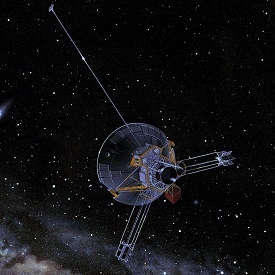
Anomalies are always fascinating because they cause us to re-examine our standard explanation for things. But in the case of the so-called ‘Pioneer anomaly,’ the Jet Propulsion Laboratory’s Slava Turyshev, working with a group of scientists led by JPL’s John Anderson, needed an explanation for practical reasons. The possibility that there was new physics to be detected had the scientists wondering about a deep space mission to investigate the matter, but missions are expensive and the case for a genuine Pioneer effect had to be strengthened or else put to rest.
All of this led Turyshev to begin a multi-year data-gathering mission of his own, scouring records related to Pioneer wherever they might be found to see if what was happening to the spacecraft could be explained. The effect was tiny enough that it was originally dismissed as the result of leftover propellant in the fuel lines, but that explanation wouldn’t wash. Something was causing the two Pioneers to decelerate back toward the Sun, a deceleration that was finally measured as being about 300 inches per day squared (0.9 nanometers per second squared).
I love Turyshev’s quote on the matter, as seen in this JPL news release:
“The effect is something like when you’re driving a car and the photons from your headlights are pushing you backward. It is very subtle.”
Subtle indeed, but combing through telemetry and Doppler data, the team made a number of memorable finds, starting with the discovery of dozens of boxes of magnetic tapes stored under a staircase at JPL itself. This one is a story I always cite when talking about the danger of data loss in a time of digital information. Fully 400 reels of magnetic tape were involved, carrying records from the 114 onboard sensors that charted the progress of each of the two missions. All this information had to be transferred to DVD, as did other data from floppy disks that had been preserved at NASA’s Ames Research Center by mission engineer Larry Kellogg.
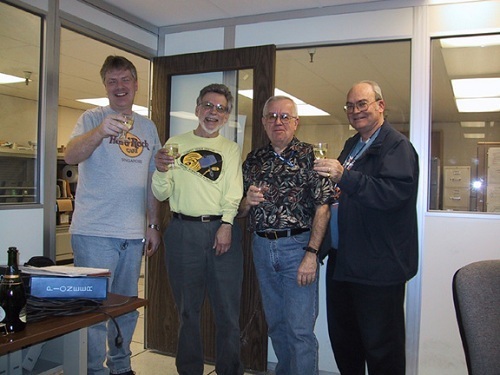
Image: For old times’ sake (and because these guys are heroes of mine), great figures from the Pioneer era, here seen celebrating after what turned out to be one of the last contacts with Pioneer 10 in 2002 (the final contact was made in January of 2003). Left to right: Paul Travis, Pioneer senior flight controller; Larry Lasher, Pioneer project manager; Dave Lozier, Pioneer flight director and Larry Kellogg, project flight technician. Credit: NASA Ames.
We came just that close to losing the key Pioneer data altogether, a reminder of the need to back up information and convert it into new formats to ensure its preservation. The Pioneers were launched at a time when data were routinely saved on punch cards which were themselves then converted into different formats at JPL, and other information had to be tracked down at the National Space Science Data Center at NASA Goddard in Greenbelt, MD. All told, Turyshev and team collected about 43 gigabytes of data and – a close call indeed – one of the tape machines needed for replaying the magnetic tapes, an item about to be discarded.
In the salvaged files from the Pioneers we learn the secret of the anomaly: Heat from electrical instruments and the thermoelectric power supply produces the effect detected from Earth, or in the words of the recently published paper on this research, the anomaly is due to “…the recoil force associated with an anisotropic emission of thermal radiation off the vehicles.” Take account of the thermal recoil force and no anomalous acceleration remains. If this work stands up, the Pioneer anomaly, well worth investigating because it seemed to challenge our standard model of physics, can be explained in a way that is consistent with that model in every respect.
The paper is Turyshev et al., “Support for the Thermal Origin of the Pioneer Anomaly,” Physical Review Letters 108, 241101 (abstract). Credit for the Pioneer image at the top of the page: Don Davis/NASA.






July 17, 2012
Remembering Ary Sternfeld
Galileo Galilei makes a brief appearance in the news this morning with word that several copies of his books, including two examples of the Sidereus Nuncius, have turned out to be forgeries. The latter, whose title is usually translated as Starry Messenger, was the first scientific presentation on observations made with a telescope, and contains Galileo’s early work on the Moon and the moons of Jupiter, among other things. One Marino Massimo De Caro, currently under arrest for massive thefts from the Girolamini Library in Naples, may have had connections with the forgeries, which are worrisome news for those of us who like to poke around in ancient manuscripts and for anyone interested in the history of science.
News of the manuscripts also puts me in mind of a paper by Danielle Briot (Observatoire de Paris), which uses Galileo in quite a different context. Briot became interested in the life and work of Ary Sternfeld (1905-1980), a prolific writer on science and a researcher who may have been the first to have used the word ‘astrobiology,’ although his work is all too little known today. Sternfeld’s 1935 article “La vie dans l’Univers” in the French science magazine La Nature looked at beliefs and hypotheses about life in the cosmos and reached conclusions remarkably similar to those under active investigation in today’s journals.

In fact, in discussing the state of the art in research into these matters, Sternfeld wrote as follows: “The development of both the natural and astronomical sciences has led to birth of a new science whose main objective is to assess the habitability of the other worlds… this science is called astrobiology.” Briot believes this is the first time the word ‘astrobiology’ appears, and it is followed up — just two years after Hitler assumed power in Germany and the German military buildup was just beginning — with a review of theories on the origin of life and even considerations about how it might be transported through space. Sternfeld thought extraterrestrial life was likely and wondered how we would discover planets around other stars.
Image: Ary Sternfeld at work, an astronautical pioneer whose work is only now being rediscovered in the west.
Galileo swings back into the discussion because the 77 years that have passed between the publication of Sternfeld’s paper and today is roughly the same interval between the publication of the Sidereus Nuncius (1610) and Fontenelle’s Entretiens sur la pluralité des mondes (Conversations on the Plurality of Worlds) in 1686. What’s striking about this is that between Galileo and Fontenelle there is a world of new thinking as an observation-enriched view of the cosmos emerged, whereas the Sternfeld paper offers a view of the universe that, with the exception of its model of planet formation, is one that could have come out of a recent science magazine.
Bernard Le Bovier de Fontenelle (1657-1757, a remarkable lifetime!) spoke to the general public in his Conversations, drawing on not just Galileo but also Copernicus, whose De revolutionibus orbium coelestium (On the Revolutions of the Celestial Spheres) had appeared in 1543. The language, significant in a scientific work at the time, was not Latin but French, presenting the conversations between a philosopher and a nobleman as they study the stars on a late-night walk. Between the time of Galileo and Fontenelle we have moved into a world keen to know more about the immensity of the universe and actively speculating on life around other stars.
If Fontenelle was a man of his time, Briot gives the impression that Sternfeld was very much ahead of his, at least where ideas about extraterrestrial life are concerned. His own life was a good deal more restricted. Born in Poland in 1905 of Jewish parents, he was unable to attend the Polytechnical School in Warsaw because of his religion and moved to France in 1924, although his application to do a doctorate in astronautics at the Sorbonne was rejected. Even so, by 1933 he had written a book on the discipline he called ‘cosmonautics,’ presenting calculations on spacecraft trajectories that proved accurate though written 25 years before Sputnik.
Briot has the rest about this remarkable man who published in both popular and professional periodicals in France and speculated actively on SETI methods using optical and radio technologies as early as 1935. It was later in that year that he and his wife moved to the Soviet Union, where he narrowly survived Stalin’s purge of Russian scientists in 1938, going on to write some 30 books and over 400 articles in a wide variety of venues. Sadly, he was not allowed a visa to return to France even when he received an honorary doctorate there in 1961. Sternfeld died in 1980 and his name is engraved on a small plaque aboard the New Horizons spacecraft honoring the pioneers of astronautics. A crater on the far side of the Moon also bears his name.
In 2010 the Space Research Center of the Polish Academy of Science (CBK PAN) organized a conference to commemorate the work of Ary Sternfeld. Although he could not attend in person, Mike Gruntman (USC) produced a video that was played at the meeting and can be seen online. The Briot paper is “Is it the first use of the word Astrobiology?” (preprint). Be aware, too, of Gruntman’s From Astronautics to Cosmonautics (2007), which describes the work of Sternfeld as well as Robert Esnault-Pelterie, another figure we’ll need to talk about soon in these pages.






July 16, 2012
Detecting Exoplanet Oceans
Is the discovery of oceans on planets orbiting distant stars within our reach? Finding such an ocean would be of immense interest from an astrobiological perspective because water on the surface is the traditional marker for a habitable zone. Astrobiology Magazine has just written up work by Nicholas Cowan (Northwestern University) and colleagues, who have been looking at the ways we might detect such oceans. The researchers are thinking ahead to a time when we have an actual image of a terrestrial world to look at, even if that image is little more than the ‘pale blue dot’ Voyager saw in its famous portrait of the Solar System. When we have identified that ‘dot,’ we can do a lot with it by studying the way its light varies as it orbits its star.
Let’s assume we deploy a starshade and use it in conjunction with the James Webb Space Telescope to block the light of the star and reveal the faint signature of the planet. A disk tens of meters wide with petal-like extensions, the starshade would be placed between the telescope and the star under observation, its shape designed to prevent the rings and refractions that would be created by a circularly shaped shade. One option under consideration is to place the starshade about 160,000 kilometers away from the telescope, which will orbit at the L2 Lagrangian point. Such a configuration could yield the image of a terrestrial world in the habitable zone, a planet whose variations in light can tell us something about what is on its surface.
Finding oceans then becomes a major first step in characterizing the planet. The Cowan paper presents the three methods that have so far been proposed for detecting alien oceans:
Changes in color
Variations in the color of the planet are useful because oceans are darker and have different colors than the surface features of continents. Watching the planet over time should reveal these changes.
Polarized light
Oceans polarize light, whose phase variations can flag the presence of water. The trick is that light also scatters off molecules in the atmosphere (‘Rayleigh scattering’), masking the effect, but rotational variation in polarization may allow us to infer the presence of an ocean.
Specular reflection
Oceans can throw bright reflections, especially when the planet is in its crescent phase, making the planet appear brighter than would otherwise be expected. Variations in reflectivity (albedo) as the planet circles its star can thus be markers for an ocean if properly interpreted.
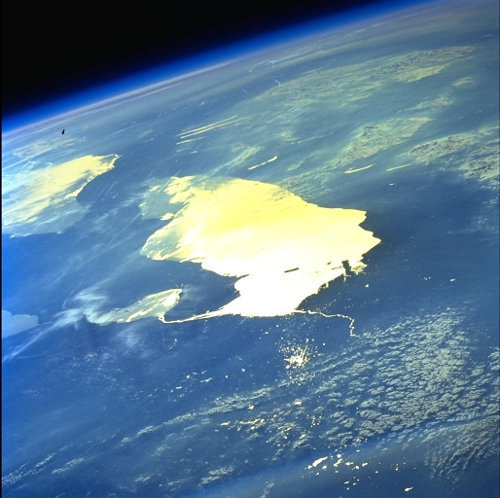
Image: Glinting sunlight off Lake Erie. Can we use this kind of specular reflection to identify the oceans of an alien world? Credit: Image Science and Analysis Laboratory/NASA JSC.
Cowan and team focus largely on the specular reflection method, noting that all three techniques have been studied in terms of cloud cover and changes in albedo due to seasonal changes on the surface. But they also identify what they call the ‘latitude-albedo’ effect, which can play havoc with these observations by mimicking the glint of an ocean when none actually exists. The reason: A planet in the habitable zone with low axial tilt (obliquity) would tend to have highly reflective snow and ice in the regions least illuminated by sunlight. A false positive for ocean glint is thus produced.
In other words, the polar regions will make the apparent reflectivity of a planet with low axial tilt increase when the planet is seen in its crescent phase, an effect that will diminish in the gibbous phase. The latitude-albedo effect thus limits our ability to use ocean ‘glint’ as a marker for water on the surface, though the authors note there are some ways around the problem. It will be necessary to study the color variations of the planet during its own rotation and during the entirety of its orbit to develop an estimate for the planet’s obliquity. The rotational albedo map that can be generated out of this should allow better interpretation of the variations in light observed. The JWST/starshade combination may be powerful enough to monitor these tiny changes.
If you’re wondering how significant the ‘glint’ effect could be, consider that Tyler Robinson (University of Washington), modeling the Earth as it would appear to a distant observer back in 2010, was able to show that the Earth would be as much as 100 percent brighter at crescent phases when modeled with the glint effect than without it. Thus specular reflection can be a major player in characterizing an exoplanet, but only if we learn how to interpret it properly.
The Cowan team’s simulation worked with a planet whose obliquity is 23.5 degrees, the same as the Earth’s, calculating light curves as they would appear to a distant observer. Subtracting out the kind of reflection that would produce an ocean glint, they still found the false positive, phase variations that mimic the glint. Planets like the Earth have enough axial tilt that the methods above can correct for the latitude-albedo effect, but the authors note that zero-obliquity planets will be extremely hard to investigate. It’s worth noting that planets like these should be fairly common around red dwarf stars, where the planet has become tidally locked to the primary.
The paper is Cowan, Abbot and Voigt, “A False Positive For Ocean Glint on Exoplanets: the Latitude-Albedo Effect,” accepted at Astrophysical Journal Letters (preprint). Thanks to Antonio Tavani for the pointer to this paper.






July 13, 2012
Pluto: Moons, Debris and New Horizons
When I was a boy, I became fascinated early on with the outer planets. The further out, the better as far as I was concerned, and as you might imagine, I had a special fascination with Pluto. In the summer, I used to haunt the library in the nearby suburb of Kirkwood (in St. Louis, where I grew up), working my way through all the books on astronomy and space I could find. Because I was reading all of them, I would encounter older volumes, some pre-dating the discovery of Pluto, and more recent tomes with details about the planet I didn’t know. It didn’t matter; I just kept reading.
What was fun about all this was that I kept expecting to find something new each time I opened a book, and was sometimes rewarded with a fact that brought this distant realm into perspective. The news that Hubble has now found a fifth moon orbiting Pluto awakens that same sense of satisfaction, for as we keep tuning up our observing skills, we’re learning much about the outer system that surprises us. The fact that this tiny dwarf planet — I would prefer to think of it as a ‘double planet’ more than a ‘dwarf’ — has such an elaborate set of moons is unexpected.
Image: Pluto’s newly discovered moon P5 (circled). Researchers are intrigued that such a small planet can have such a complex collection of satellites. The new discovery provides additional clues for unraveling how the Pluto system formed and evolved. The favored theory is that all the moons are relics of a collision between Pluto and another large Kuiper belt object billions of years ago. Credit: NASA, ESA, and M. Showalter (SETI Institute).
The existence of P5 is another useful piece of information for the New Horizons team as their spacecraft streaks toward its 2015 encounter at Pluto/Charon. The moon, currently designated P5, looks to be between 10 and 25 kilometers across, residing in a 93000 kilometer circular orbit that is evidently co-planar with the other four satellites. With five moons, Pluto is likely home to a good deal more debris that we haven’t yet found, a factor in working out the safest trajectory for the spacecraft. We’ll be watching Pluto carefully up to and beyond the New Horizons encounter.
A Not So Quiet Hibernation
Meanwhile, New Horizons, the hero of this piece, continues its relentless journey, now almost 24 times as far from the Sun as our own planet and once again in a state of hibernation. The ‘deep cruise’ phase of the mission lasts until the encounter operations begin to accelerate in the summer of 2014, with closest approach to Pluto on July 14, 2015. Even though most of its subsystems, including science instruments and flight electronics, are turned off, the Student Dust Counter (SDC) is to be left on during the hibernation period, measuring dust impacts as the spacecraft pushes deeper into the system than any dust detector has ever been sent before.
Yes, the Voyagers can measure dust impacts, but they do so with their plasma wave instrument rather than through an actual dust detector. Both spacecraft have been detecting micron-sized impacts for years, noted because the impact of a dust particle causes it to be vaporized and heated to a plasma of electrons and ions. The resulting plasma cloud creates a voltage pulse in the plasma wave receiver. Researchers can count the impacts over a period of time and learn much about the density of the impacting particles in the outer interplanetary medium.
We need to learn about dust in the outer system, of course, because as we push deeper and move faster small impacts become much larger factors, risking the very life of the mission if we’re talking about interstellar flight speeds. Interestingly, the Voyager dust measurements show the number density of impact particles to be more or less the same for both Voyager 1 and 2, a noteworthy item given that Voyager 2 is much closer to the ecliptic than Voyager 1. That suggests the outer system dust both spacecraft are running into is likely cometary in origin, or at least that it does not originate from a planetary source.
But back to New Horizons. The latest report from the spacecraft team now tells us that the Solar Wind Around Pluto (SWAP) and Pluto Energetic Particle Spectrometer Science Investigation (PEPSSI) instruments will also remain active during hibernation, representing a major upgrade from the instruments on the Pioneer and Voyager spacecraft. The report quotes Matthew Hill (JHU/APL) on their ability to measure charged particle radiation from the solar wind and elsewhere:
“It’s been more than 30 years since we’ve had a spacecraft venture beyond Saturn, and it’s the first time we’ve had observations from this region while having supporting measurements both farther out [from Voyager 1 and 2] and closer to the Sun [missions at Mercury, Earth and Saturn]. Events associated with solar flares and coronal mass ejections that propagate through the solar wind plasma can now be observed throughout the heliosphere as never before. With solar activity on the rise, the timing is great to have these state-of-the-art New Horizons instruments observing the heliosphere.”
The report is calling the new observations ‘enhanced science’ — the use of SWAP and PEPSSI during hibernation had not been part of the original mission schedule — and the hope is that it will provide a welcome additional dataset as we continue our study of the heliosphere. With the Pluto/Charon encounter ahead, we have much to look forward to, but even after the encounter, we’ll eventually be using the James Webb Space Telescope’s infrared capabilities to probe this icy realm. Who knows how many more moons of Pluto, or Kuiper Belt bodies beyond, we’ll have uncovered by then?






July 12, 2012
Interstellar Flight Goes Mainstream
Paging back through Kelvin Long’s book Deep Space Propulsion (Springer, 2011) last night, I was reminded that Freeman Dyson had written about his disillusionment with nuclear pulse propulsion methods long after Project Orion was terminated. The passage is in his autobiographical account Disturbing the Universe (Basic, 1981), which caught Long’s attention and led him to reprint it. Here’s a snippet of Dyson’s reflections:
Sometimes I am asked by friends who shared the joys and sorrows of Orion whether I would revise the project if by some miracle the necessary funds were suddenly to become available. The answer is an emphatic no… By its very nature, the Orion ship is a filthy creature and leaves its radioactive mess behind it wherever it goes… Many things that were acceptable in 1958 are no longer acceptable today. My own standards have changed, too. History has passed Orion by. There will be no going back.
Long speculates that Dyson may simply have been referring to Orion as an Earth-launch vehicle, leaving open options for construction and deployment in deep space, but my own sense is that the passage above means just what it says. When I interviewed Dyson for Centauri Dreams (the book) back in 2003, he made it abundantly clear that he considered the matter closed. He criticized nuclear methods because they could use no more than one percent of the mass with any nuclear reaction, and said he was much more enthusiastic about laser and microwave beaming and pellet propulsion concepts like those first developed by Clifford Singer back in the ‘70s and later expanded significantly by Gerald Nordley.
Interstellar Flight in the Public Eye
Long covers the Orion concept in detail as well as Medusa, a remarkable attempt to fuse pulsed propulsion with sail technologies (we need to talk more about Medusa soon). But I was really digging into his book in relation to Robert Bussard, whose 1960 paper “Galactic Matter and Interstellar Flight” (citation below) is in my view the real marker for the emergence of interstellar studies. To be sure, there were key papers before this, including the significant contributions of Leslie Shepherd and Eugen Sänger, both of whom I want to talk about in coming days. But what you get with Bussard is an idea published in an academic journal that is found and brought emphatically into the public consciousness in ways that transform public thinking.
If the beauty of beamed propulsion is that it removes the need to carry huge stores of propellant, the advantage of Bussard’s ramjet concept was that it harvested what it needed from the medium. Bussard announced his intention to speed up interstellar travel times enormously:
… by abandoning the interstellar rocket entirely, turning to the concept of an interstellar vehicle which does not carry any of the nuclear fuel or propellant mass needed for propulsion, but makes use of the matter spread diffusely throughout our galaxy for these purposes. By rough analogy with its atmospheric counterpart we call this an interstellar ramjet. Other possible types might include, vehicles which carry all of the nuclear fuel on board and only use swept-up galactic matter as inert diluent added to the propellant stream analogous to the operation of ducted rockets in atmospheric flight and all variations between these two extremes. Study of the performance of these fuel-carrying vehicles is deferred to a future paper.
To my knowledge, Bussard never wrote this future paper — if I’m wrong about that, I hope someone will correct me. His ideas, of course, generated an influx of new concepts tweaking the ramjet and taking the idea of matter collection in deep space in entirely new directions.
We’ve looked at problems with the original Bussard design in these pages before, focusing especially on the proton/proton fusion reaction and the power needed to exploit it. A number of theorists have suggested workarounds, including Centauri Dreams regular Al Jackson, who in several papers explored a laser-powered ramjet design that I want to talk about next week. For today, though, the focus is on reaction to the Bussard paper of 1960, for it was quickly seized upon by science fiction writers and scientists alike. The book Intelligent Life in the Universe, co-authored by Carl Sagan and Iosif S. Shklovskii, focused on time dilation at relativistic velocities and the way to the stars seemed to open.
Time Dilation Takes Center Stage
Intelligent Life in the Universe came out in 1966, a greatly expanded version of Shklovskii’s original Russian text of 1962. It is the coupling of relativistic time dilation and the Bussard ramjet idea that seized the imagination of science fiction writers. Sagan and Shklovskii could show that at an acceleration of 1 g, only a few years (ship-time) is required to reach the nearest stars, while (as experienced again aboard the ship) only 21 years takes you to the galactic center, and 28 years to the Andromeda galaxy. There being no time dilation on the home planet, the elapsed time there as the star mission proceeds, for distances beyond about 10 light years, roughly equals the distance of the destination in light years. In other words:
…for a round-trip with a several-year stopover to the nearest stars, the elapsed time on Earth would be a few decades; to Deneb, a few centuries; to the Vela cloud complex, a few millennia; to the Galactic center, a few tens of thousands of years; to M 31, the great galaxy in Andromeda, a few million years; to the Virgo cluster of galaxies, a few tens of millions of years; and to the immensely distant Coma cluster of galaxies, a few hundreds of millions of years. Nevertheless, each of these enormous journeys could be performed within the lifetimes of a human crew, because of time dilation on board the spacecraft.
Einsteinian time dilation had been considered long before this, of course, and it shows up in science fiction in early stories like Robert H. Wilson’s “Out Around Rigel,” which ran in Astounding Stories in December of 1931. But when Sagan and Shklovskii combined time dilation with a serious discussion of communications between galactic civilizations as enabled by Bussard-style ramjets, the notion went from utterly theoretical to a matter that mixed science with engineering. Bussard’s ideas went on to inspire a wave of ramjet-related studies, as we’ve already seen, and also inadvertently triggered the study of magnetic sails as braking devices.
Image: The Bussard ramjet, which opened serious speculation about attaining speeds close to c. Credit: Adrian Mann.
The Ramjet in Science Fiction
Meanwhile, we can think about the later science fiction that flowed from the Bussard ramjet. I usually cite Poul Anderson’s Tau Zero in that regard, a 1970 novel that grew out of a 1967 short story (“To Outlive Eternity,” which ran in Galaxy a year after Sagan and Shklovskii). But we can add to Anderson’s tale of a runaway starship the work of Larry Niven, who described Bussard vessels in his 1976 novel A World Out of Time:
The starships were Bussard ramjets. They caught interstellar hydrogen in immaterial nets of electromagnetic force, compressed and guided it into a ring of pinched force fields, and there burned it in fusion fire. Potentially there was no limit at all on the speed of a Bussard ramjet. The ships were enormously powerful, enormously complex, enormously expensive.
I pulled this quote from Technovelgy.com, which routinely looks at the intersection of science and science fiction. The first part of Niven’s novel appeared in Galaxy in 1971 as a short story called “Rammer,” another indication that Bussard’s notions were quickly embraced. Gregory Benford uses a greatly modified Bussard design in his Galactic Center novels, dodging the proton-proton fusion problem in well-vetted ways we’ll discuss next week. Sagan went on to refer to the ramjet in the popular television series Cosmos and the book that accompanied it, but the ultimate sign of Bussard’s ideas reaching full public awareness may have been the ‘Bussard collector’ used in the Star Trek universe as part of StarFleet’s propulsion paraphernalia.
It could be argued that much was coming together anyway by the early 1960s, and two years after Bussard described the ramjet, Robert Forward would put the idea of a laser-propelled lightsail into the public consciousness in an article in Missiles and Rockets. But I’ll give the nod to Robert Bussard, with a major assist from Sagan and Shklovskii, for turning the interstellar idea into public currency by suggesting that although the engineering was far beyond our skills, the basic physics did not rule out human travel to the stars. And if you’re a science fiction writer with a need to get around the galaxy quickly, Bussard will always be a contender.
The Bussard paper is “Galactic Matter and Interstellar Flight,” Astronautica Acta Vol. 6 (1960), pp. 179–94 (available online).






May 14, 2012
Remembering Dandridge Cole
I’ve been thinking all weekend about Dandridge Cole, the aerospace engineer and futurist whose death at age 44 deprived interstellar studies of one of its most insightful advocates. Cole died in 1965, just five years before a deadline he himself set (in 1953!) for a manned landing on the Moon. But then, the former paratrooper from Ohio thought a lot about the future and the need for a kind of ‘future studies’ that would look at current technological trends and project going forward just as conventional historical studies reconstruct what happened to us in centuries past.
The heart attack that struck Cole down in his office at General Electric’s Space Technology Center in Valley Forge, PA deprived us of much, but we do have the substantial legacy of a number of articles and monographs, along with three books, among which Islands in Space: The Challenge of the Planetoids, written with Donald Cox (Chilton Books, 1964) may stand out as the most influential. Andreas Hein, who is heading up the Project Hyperion worldship study for Icarus Interstellar, harks back to the inspiration of Cole in The Hollow Asteroid Starship: Dissemination of an Idea, published on the Icarus blog late last week.
Image: Dandridge Cole, who coined the term ‘macro-life’ to refer to human colonies in space and their evolution. Credit: Wikimedia Commons.
The idea is now a familiar one to science fiction fans, especially after its appropriation by George Zebrowski in his 1979 novel Macrolife, but in the mid-60s, the notion of hollowing out an asteroid to create an interstellar vehicle would hardly have been common currency. As Hein comments in his article, what Cole was doing was creating a bridge between the kind of space colonies that Gerard O’Neill would make famous and the worldships that might one day take a large human colony, a self-contained society, to a distant star.
The idea has resonance because star journeys may turn out to be multi-generational affairs that evolve naturally out of our eventually mastered skills at creating self-contained habitats in nearby space. If you can build a ship large enough and comfortable enough to re-create a planet-like environment within it, then living there might become so natural that future generations born aboard the craft would see no need for planetary living. A colony world like that might eventually disengage from the stellar system that created it and begin a voyage that would have no other aim than continuing exploration, taking ‘home’ with the crew wherever it went.
Artist and futurist Roy Scarfo provided the artwork in Cole’s 1965 book Beyond Tomorrow. On his site, Scarfo recalls going with Cole in the ambulance and being in the hospital at the time of his death. A futurist to the end, Cole had planned to have his body frozen and had made a serious study of cryogenics:
When we got to the hospital, the hospital personnel took him to a room. When they informed me that Dan was dead, and knowing that Dan wanted to be frozen, I called Ettinger, who I believe was in Chicago and who was the authority on cryogenics at the time. He knew Dan and instructed me to get in touch with a hospital and make arrangements for freezing. I believe it was the University of Pennsylvania hospital. I was racing against time as every second counted to preserve the body.
Personal and legal issues persuaded the family not to proceed with the arrangements, and Cole was buried conventionally, with Scarfo serving as one of the pallbearers.
Scarfo also wrote an appreciation of Cole on Alex Michael Bonnici’s Discovery Enterprise site in which he recalls working with Cole on Beyond Tomorrow in the evenings after work in Scarfo’s office at GE, where they would go over the chapters word by word. Says Scarfo:
Our work together gave us a handle as “the weird couple” because of the way-out material we were producing together. Today many of those concepts are as common as soap. The majority of our work together was done outside our regular responsibilities at GE, although sometimes they overlapped. We would meet almost daily for lunch at the cafeteria and afterward walk and talk during the rest of our lunch hour. This went on for years.
We’re surely due for a renewed look at Cole’s contribution and his ideas, especially as attention now turns to mining and the other possibilities the asteroids represent. Alex Michael Bonnici wrote his own tribute to Cole in 2007, one that encapsulates the asteroid-as-habitat idea:
In 1963, Cole wrote Exploring the Secrets of Space: Astronautics for the Layman with I. M. Levitt. In this book they suggested hollowing out an ellipsoidal asteroid about 30 km long, and rotating it about its major axis to simulate gravity. By reflecting sunlight inside with mirrors, and creating, on its inner surface, a pastoral setting an asteroid could be transformed into a permanent space colony. Cole and Cox also envisioned that asteroids would provide the raw materials to form the basis of a spacefaring civilization. And, that asteroidal materials would also serve terrestrial needs. In their view these materials could be transported using mass drivers or linear motors. Cole’s work largely presages that of Gerard K. O’Neill by more than a decade.
Extend the notion to an interstellar journey and you get what Cole would call a ‘nomadic pseudo-Earth’ that would be the seeding ground for so-called ‘macro-life.’ Cole’s view was that future human evolution inside such habitats, which includes synchrony between humans, their environment, and their technology, creates a ‘new large-scale life form.’ It was one he felt we must become, for in the years not long before his death, he had become extremely worried about our species not only in terms of population pressure but also weapons proliferation. Moving into space would be the chance to give humanity a progressing series of new and better starts.
Image: The populated asteroid from without and within. Credit: Roy Scarfo.
Here’s TIME’s take on Cole’s macro-life views in a January 27, 1961 article:
Cole proposes the development of giant spaceships, each of which would contain at least 10,000 individual humans who would function rather like the cells of a multicelled animal; collectively, they would constitute what Cole calls a unit of “macrolife.” Stowed along with the humans in the vast body of the macroorganism would be domestic animals, plants, raw materials, machines and computers, as well as microfilms of all the books in the Library of Congress. A fully developed unit of macrolife would have rocket propulsion to enable it to move at will around the solar system. It would be able to live independently almost anywhere in space, but its normal habitat would be the asteroid belt between Mars and Jupiter where it could feed upon the mineral riches of the asteroids.
Macrolife in space would be self-adjusting, spinning off new units aboard new asteroids as necessary, but Cole freely acknowledged the difficulties in creating self-sustaining biospheres, urging that underwater bases or other sealed environments would need to become experimental testbeds for his ideas. A spacefaring species aboard a hollowed-out world, spun up for artificial gravity and provided with many of the amenities of planetary life, could well take to the stars one day. But in any case, Cole’s legacy of insightful probings of the human future will endure, the work of a man whose all too short life yielded much and has inspired interstellar theorists ever since.
For more on Cole, see Joseph Friedlander’s In Praise of Large Payloads for Space.






May 11, 2012
Pushing Beyond Pluto
What would you do if you had a spacecraft pushing toward the edge of the Solar System with nothing much to do? The answer is to assign it an extended mission, as we found out with the two Voyagers and their continuing data return that is helping us understand the boundaries of the heliosphere. In the case of New Horizons, NASA’s probe to Pluto/Charon, two extended missions may be involved after Pluto, the first being a flyby of one or more Kuiper Belt targets, the second being a further look at what is actually going on where the solar wind meets the interstellar medium.
Alan Stern, principal investigator for New Horizons, comments on the possibility in his latest report on the mission, noting that a second extended mission isn’t out of the question, and adding that New Horizons won’t make it as far as the Voyagers before it runs out of power. But 90 to 100 AU seems a possibility, which would provide a useful supplement to Voyager data. Remember that New Horizons carries two instruments ideal for this part of the system. The first is the Solar Wind Around Pluto (SWAP) plasma instrument, the second the Pluto Energetic Particle Spectrometer Science Investigation (PEPSSI). All this is in addition to what the spacecraft’s dust counter, its two imagers and its ultraviolet spectrometer may tell us.
Stern’s report on New Horizons comes at the same time we have word, from a new paper in Science, that the assumed ‘bow shock’ at the outer edge of the heliosphere may not actually exist. The bow shock is at the boundary between the solar wind pushing out from the Sun and the interstellar medium, an area of presumed turbulence that has been observed around other stars. The new paper from David McComas (SwRI) and colleagues presents findings from the Interstellar Boundary Explorer (IBEX) that show the Sun is moving more slowly in relation to the interstellar medium than previously thought, slow enough to prevent a bow shock from forming.
Image: IBEX has caught the interstellar wind that surrounds and compresses our heliosphere and has found that it travels more slowly and in a different direction than previously thought. This new understanding has important implications for the size and shape of the heliosphere and may inform the history and future of the solar system. Credit: SwRI.
Maybe New Horizons can help us clarify the situation with studies of the outer heliosphere, but we still lack a mission that could get us out as far as the bow shock region itself (the Voyagers have entered the heliosheath, but their signals will surely be lost before getting to the needed 200 AU or more from the Sun). All of this ties in with recent Cassini results suggesting that the heliosphere is more spherical than comet-shaped, so perhaps the interactions at system’s edge aren’t quite as fierce as has been thought. We need Innovative Interstellar Explorer to learn more, or a comparable mission specifically designed to penetrate into true interstellar space.
New Horizons in the Kuiper Belt
Meanwhile, our Pluto/Charon mission is, says Stern, doing just fine, having exited a period of hibernation on April 30 to begin a series of extensive systems checkouts. The spacecraft’s Pluto encounter occurs in the summer of 2015, but it should take a year to get all the encounter data back to Earth due to the slow data transmission rates at that distance. It’s after that that the first extended mission, subject to approval by NASA, would study objects in the Kuiper Belt. The spacecraft should have about 40 percent of its fuel still available, so a choice of KBOs should be possible, assuming the ongoing hunt for likely candidates turns up workable targets.
The New Horizons team has been using Earth-based telescopes to hunt for KBOs, but so far none has been identified that would be within range of New Horizons. It’s a tricky search, and one Stern assumes will succeed, but his recent report explains some of the problems:
First, the only KBOs within our reach are likely to be small, roughly 50 kilometers in diameter. Because they are small and far away, they will be faint as seen from Earth. In fact, calculations show that the KBOs we need to find are going to be about 25,000 times fainter than Pluto, which is itself about 10,000 times fainter than the eye can see. This means we have to search for objects with the largest telescopes and most sensitive astronomical cameras on Earth.
The second factor making the search tough is that our trajectory is pointed at the heart of the Milky Way’s densest star fields — those of the galactic center in the constellation Sagittarius. So our search is kind of a “needle in a haystack” hunt for very faint objects slowly moving against regions of the sky thick with stars!
All I could think of when I read that was an image of Clyde Tombaugh working the blink comparator at Lowell Observatory in 1930. I wonder what he would have thought then of the chances for tracking a target 25,000 times fainter than the dim planet (well, dwarf planet) he eventually found. The New Horizons effort should have at least one target defined by 2015, at which time an engine burn in the fall of that year would change the spacecraft’s trajectory to reach the first KBO, a journey that — if the team’s calculations are accurate — should last three or four years and perhaps longer. That could place the first KBO flyby as early as 2018 or as late as 2021.
What’s exciting about Stern’s report this time around is his statement that any target KBO will be approached at distances perhaps as close as the Pluto/Charon flyby, which means we should get images from the KBOs that are as detailed as those from Pluto. The down side: With no other Kuiper Belt mission in the works, we’ll need every bit of New Horizons’ observations on KBO surface composition and features, temperatures, moon or rings system and anything else the brief encounter can deliver, for as Stern puts it, “New Horizons is very likely to be the only spacecraft that will explore KBOs in the lifetime of most people alive today.”
Or maybe not. Let’s assume that first extended mission into the Kuiper Belt will be approved, which will yield not only close-up KBO images but also more distant observations of KBO satellites as well as dust particle distribution data. And while we get behind missions like Innovative Interstellar Explorer and push to see them implemented, let’s also cross our fingers for that second extended mission that would keep New Horizons active until it goes silent somewhere out around 100 AU. As the latest IBEX findings remind us, we know all too little about the boundary between our Solar System and the interstellar gulf beyond.
The new IBEX findings are in McComas et al., “The Heliosphere’s Interstellar Interaction: No Bow Shock,” published online in Science 10 May 2012 (abstract).






May 10, 2012
KOI-872: Timing is Everything
It’s no surprise that the techniques we’re using to look for moons around exoplanets should start turning up new planets on their own. We’re still looking for that first exomoon, but a team of researchers working with the Hunt for Exomoons with Kepler (HEK) project has found transit variations that have revealed a second planet around a star already known to have one transiting planet. The star is the intriguing KOI-872 (KOI stands for Kepler Object of Interest), the data on which were recently released by the Kepler team and analyzed swiftly by HEK.
Kepler’s transit methods examine the change in starlight when an exoplanet passes in front of the star being observed. This lightcurve, however, can tell more than a single tale. David Kipping (Harvard-Smithsonian Center for Astrophysics) is head of HEK and second author of the paper on the new work, which was published online today in the journal Science:
“For a planet following a strictly Keplerian orbit around its host star, the spacing, timing and other properties of the observed transit light curve should be unchanging in time. Several effects, however, can produce deviations from the Keplerian case so that the spacing of the transits is not strictly periodic.”
Those effects are clear cut, changes in how long the transit takes (Transit Duration Variation, or TDV), and changes to when it actually occurs (Transit Timing Variation, or TTV). These deviations are sensitive to objects as small as 0.2 Earth masses, which shows their utility in hunting for large exomoons. In the case of the Sun-like star KOI-872, transits of the known planet show time variations of two hours. The TTVs are large and precise enough to allow scientists to calculate the orbit of the second planet. According to Kipping, both the transiting planet and the unseen planet perturbing its orbit are Saturn-class worlds. Moreover, they orbit close to a 5:3 mean motion resonance, accounting for the size of the timing variations.
Image: Using Kepler Telescope transit data of planet “b”, scientists predicted that a second planet “c” about the mass of Saturn orbits the distant star KOI-872. This research, led by Southwest Research Institute and the Harvard-Smithsonian Center for Astrophysics, is providing evidence of an orderly arrangement of planets orbiting KOI-872, not unlike our own solar system. Credit: Southwest Research Institute.
You may recall from last fall the story of Kepler-19b (discussed here in On Planets and What We Can See), a probable mini-Neptune some 650 light years away in the constellation of Lyra. Researchers at the Harvard-Smithsonian Center for Astrophysics were able to uncover a second world in the same system, Kepler-19c, by studying the transit timing variations of Kepler-19b. In this case, the timing variations were about five minutes long, but other than revealing the planet’s existence, they allowed no further deductions about its size or composition. In fact, the prospects — all consistent with the limited data available — ranged from a rocky planet on a circular five-day orbit to a gas giant on an oblong 100-day orbit.
But the new planet around KOI-872 is another matter entirely, and in Kipping’s words represents the transit timing variation model coming into full maturity, allowing us to measure the mass of the unseen planet and to determine the 5:3 orbital resonance. Moreover, we get tight constraints on the inclination, semi-major axis and eccentricity of both planets, which indicate they follow circular, co-planar orbits much like planets in our own Solar System. We now know that the unseen planet orbits its star every 57 days. Further Kepler observations will allow us to refine these details and tune up TTV and TDV methods for future planet and exomoon discoveries.
Image: Scientists analyzed Kepler Telescope data and identified KOI-872 as a stellar system where measured transits of a planet orbiting the star show large time variations (the shifting bumps in the data) indicative of a hidden companion. A team led by Southwest Research Institute and the Harvard-Smithsonian Center for Astrophysics determined that the observed variations can be best explained by an unseen planet about the mass of Saturn orbiting the host star every 57 days. Credit: Southwest Research Institute.
When the HEK team went to work on KOI-872, it was motivated in part by the fact that the transiting planet was large enough to hold on to a large moon of the size that current TTV techniques could uncover. The large TTVs yielded a planet rather than a moon in this case, but future finds of large moons around gas giants in the habitable zone will give us some idea as to whether single, rocky planets are the only likely venue for life. Are there as many habitable moons in the galaxy as habitable planets, or even more? HEK is the first step toward helping us find out.
The paper is Nesvorný, Kipping et al., “The Detection and Characterization of a Nontransiting Planet by Transit Timing Variations,” published online in Science May 10 2012 (abstract).






Paul Gilster's Blog
- Paul Gilster's profile
- 7 followers



